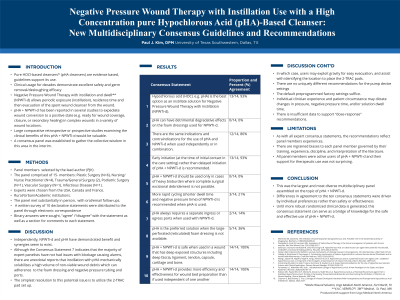Practice Innovations
(PI-012) NPWT with Instillation Use with a Pure High Concentration Hypochlorous Acid (HOCl) Based Cleanser: New Multidisciplinary Consensus Guidelines and Recommendations

Paul J Kim DPM, MS and Debashish Chakravarthy, Ph.D
Introduction: The use of hypochlorous acid as a wound cleanser is recommended by many guidelines, and is supported by many publications. High concentrations of the hypochlorous acid (approx. 300 ppm) helps the cleanser remove germs, and associated debris and necrotic tissue. The mechanical action of this cleanser can be increased quite effectively via the use of supplemental mechanical processes, such as negative pressure wound therapy (NPWT), which may be able to be operated in the instillation and the dwell mode. However, it is known that some skill is required to combine the two technologies (HOCl cleanser, the NPWT i-d device) so each technology can be relied upon to deliver the best clinical effect. A consensus panel was established to gather the collective wisdom in this area.
Methods: The panel comprised of 15-members which include the disciplines of Plastic Surgery (N=6), Nursing/Nurse Practitioner (N=4), Trauma/General Surgery (2), Podiatric Surgery (N=1), Vascular Surgery (N=1), Infectious Disease (N=1). The panelists represent the major geographic areas (east, west, central, north, south) in the United States of America, 1 region in France, and 1 province in Canada. They also represent rural and urban hospitals, and academic institutions. 10 relevant questions were created for panel discussion.
Results: This paper contains the results of a 15-member multidisciplinary clinician panel and the results of a consensus survey with recommendations consisting of 10 declarative statements focused on pHA + NPWTi-d.
Discussion: This is the largest and most diverse multidisciplinary panel ever assembled on the topic of pHA + NPWTi-d. Although there were differences in agreement to the 10 statements, these differences appear to reflect individual preferences rather than safety or effectiveness. pHA + NPWTi-d imparts a beneficial effect to wound bed preparation to a positive state for wound closure/coverage or for secondary wound healing. Independently, NPWTi-d and pHA have demonstrated benefit and when used in combination there may be an even greater synergistic effect.
Methods: The panel comprised of 15-members which include the disciplines of Plastic Surgery (N=6), Nursing/Nurse Practitioner (N=4), Trauma/General Surgery (2), Podiatric Surgery (N=1), Vascular Surgery (N=1), Infectious Disease (N=1). The panelists represent the major geographic areas (east, west, central, north, south) in the United States of America, 1 region in France, and 1 province in Canada. They also represent rural and urban hospitals, and academic institutions. 10 relevant questions were created for panel discussion.
Results: This paper contains the results of a 15-member multidisciplinary clinician panel and the results of a consensus survey with recommendations consisting of 10 declarative statements focused on pHA + NPWTi-d.
Discussion: This is the largest and most diverse multidisciplinary panel ever assembled on the topic of pHA + NPWTi-d. Although there were differences in agreement to the 10 statements, these differences appear to reflect individual preferences rather than safety or effectiveness. pHA + NPWTi-d imparts a beneficial effect to wound bed preparation to a positive state for wound closure/coverage or for secondary wound healing. Independently, NPWTi-d and pHA have demonstrated benefit and when used in combination there may be an even greater synergistic effect.

.png)